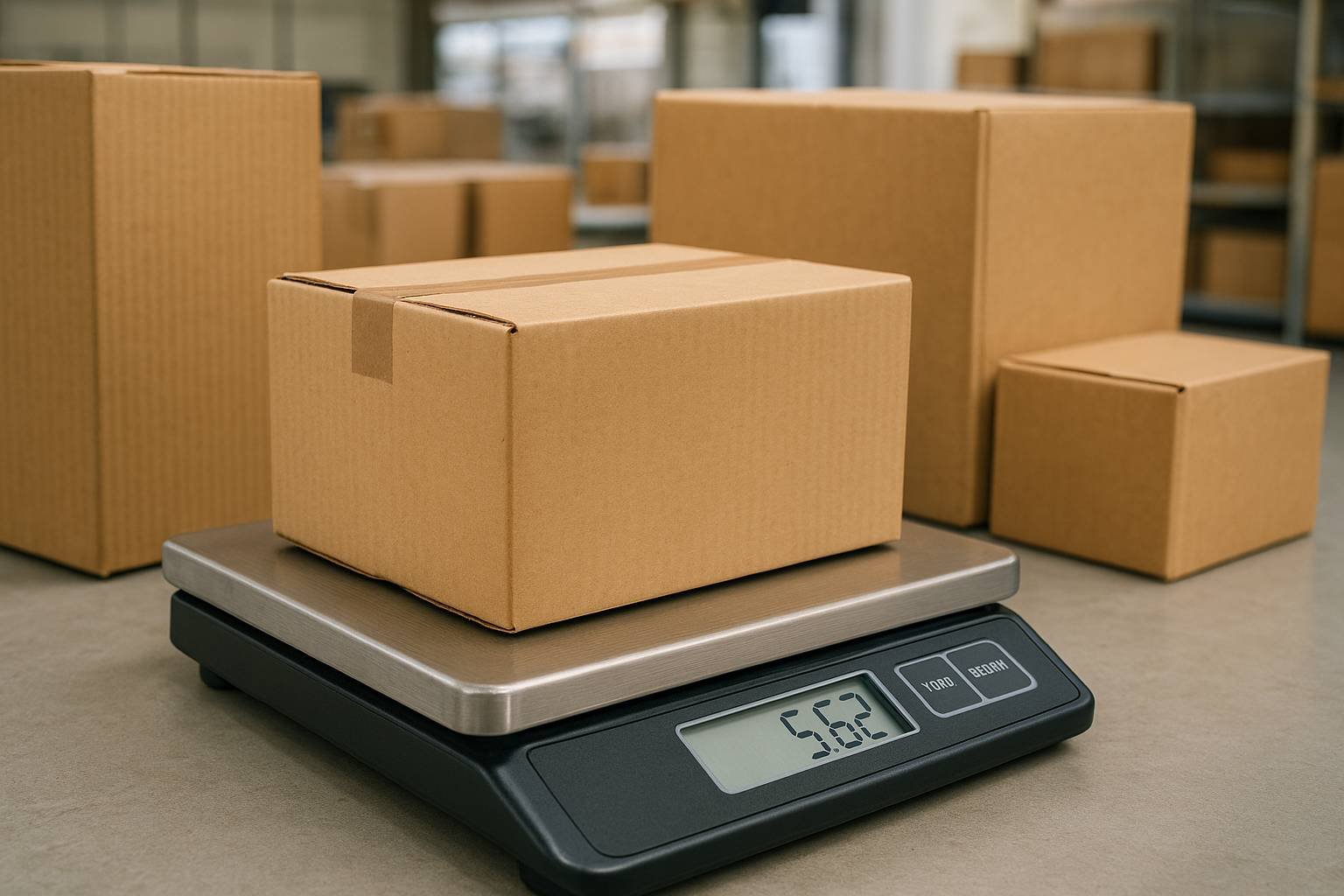How Much Does a Cardboard Box Weigh? Complete Guide for USA Packaging

More than 90% of brands in the USA ship their products in cardboard packaging. Because it is economical and easy to customize into an innovative shape, size, and style. On top of that, another reason for its extensive use by multiple industries (retail, cosmetic, food, and electronics) is its sustainable nature. This means with zero contribution to the planet’s waste brands can build a green image. However, with great popularity comes great responsibility. And the very first one is, is cardboard durable enough to protect fragile items? This point brings us to a technical question. How much does a cardboard box weigh? The answer to this question is crucial as the weight of a box helps in cost calculation and product safety. Therefore, this blog covers a detailed analysis of how to determine the different weights of a cardboard box.
The significance of understanding box weight
Brands usually measure the size of their products to calculate the right cardboard box dimensions for perfect fitting. However, knowing a box’s weight is vital as it offers numerous benefits. Such as:
Cost Management
Although cardboard is economical, it is not free of cost. Therefore, it is necessary to comprehend the basic knowledge of box weight. As it helps in estimating the right amount of material needed for packaging and reduces extra cost. Secondly, the actual weight and the dimensional weight of packaging are used to calculate the shipping fees. For example, a lightweight or small-sized box will have a lower shipping cost. Therefore, with this effective information, you can manage your custom packaging boxes within your budget.
Safety and handling
Shipping carriers have certain weight restrictions. Exceeding their limits can lead to delayed deliveries and penalties. However, if you know how much a cardboard box weighs. You can adhere to weight regulations. And save yourself from unnecessary legal issues. Moreover, with accurate weight, it becomes easy to decide the shipping method and streamline storage.
Packaging and material selection
Transportation can sometimes be rough and bumpy. Which often leads to product damage. But if you have a good grasp on packaging weights, you can choose the right material without difficulty. Such as single wall or double wall. In this way, you can maintain your product integrity.
Key factors influencing a cardboard box’s weight
It’s no constant rule that the cardboard box size and dimensions determine the weight of a box. There are several other factors on which the weight depends. Take a look at them.
Material thickness
A cardboard box’s thickness has a significant role in its weight. Based on thickness, cardboard packaging boxes is divided into three types. Single-wall, double-wall, and triple-wall. Single-wall cardboard is lightweight and can be used for almost every product. Whereas triple-wall cardboard is thicker, bulky, and dense, and is used for industrial items.
Moisture content
Cardboard is a hygroscopic material. This means it has the capacity to absorb and retain moisture. Thus, moisture can increase its weight.
Additional features
A cardboard box can be customized as per customer convenience. Therefore, many brands incorporate handles, special coatings, and embellishing add-ons like ribbons in their box design. These elements have a mass of their own and add a significant weight to the box
How do you estimate the weight of a cardboard box?
From the very start the first question is how much does a cardboard box weigh?. Although the most accurate way to use a weighing scale is. However, professionally a formula is used to get a close weight estimation. For this purpose, you need the right cardboard box measurements. After that, multiply the length, width, and height of a box and divide it by a coefficient. It will give you the exact weight of a box. But, it is a point to remember that the coefficient varies with the weight unit. The units used for measuring weight are:
- Pounds (lbs.)
- Ounces (oz.)
- Kilograms (kg)
- Grams (gm).
How much does a cardboard box weigh in pounds?
Scientifically and industrially, a metric system of units is followed. However, in the USA, a U.S. customary unit system is followed. Here the weight is measured in pounds and ounces. In order to calculate the box weight in pounds, divide your cubic dimensions by a coefficient value 166. This means the formula to calculate the weight will be:
Cardboard box weight = Length x Width x Height / coefficient
Suppose the dimensions of a cardboard box are as follows:
- Length = 12″
- Width = 12″
- Height = 12″
- The weight of a cardboard box will be:
- CBW = 12 x 12 x 12 / 166
- CBW = 1728/166
- CBW = 10.4 pounds
In this way, a small-sized cardboard box measuring 4″ x 4″ x 4″ will weigh 0.38 pounds. Whereas a large-sized box with dimensions of 40″ x 12″ x 14″ will be 40.48 pounds.
How much does a cardboard box weigh in ounces?
If you are good at calculation, you can determine your box weight in ounces too. Just multiply your weight in pounds by 16. And your weight units will be converted into ounces. In accordance with the formula the equation for ounce conversion will be:
Box Weight = (Length x Width x Height / 166) x 16
Now consider the following dimensions to calculate weight in ounce:
- Length = 24″
- Width = 18″
- Height = 18″
- BW = (24 x 18 x 18 / 166) x 16
- BW = 46.8433 x 16
- BW = 749.49 ounces
It is often a frequently asked question, what is the purpose of weight estimation in ounces when pounds is an easy way? Measuring box weight in ounces can help brands to know how much a small cardboard box weighs? Because, ounces offer a more precise weight and measurements than pounds. Moreover, ounces provide greater accuracy in calculating shipping charges.
Weight of a cardboard box in grams and kilograms
Calculating the weight in grams and kilograms is quite technical. For this you will require box dimensions in centimeters (cm) rather than inches. Then multiply the length, width, and height of your box and divide it by a coefficient. Here, the coefficient value will be 6000 to convert cubic meters into kilograms. For the conversion of inches into centimeters, we use a formula:
- Inches x 2.54 = cm
- Thus, the weight of a 14″ x 14″ x 14″ box in kilograms will be:
- 14″ x 2.54 = 35.56 cm (dimension in cm)
- BW = (L x W x H) / 6000
- BW = (35.56 x 35.56 x 35.56) / 6000
- BW = 44966.103/6000
- BW = 7.4943 kg
For calculating the cardboard box weight in grams, multiply the kilogram weight by 1000. So the weight of a 14″ x 14″ x 14″ box in grams will be 7494.3 grams.
What is the ideal weight for shipping cardboard boxes?
There is no ideal weight for a box for delivering products through cargo or shipping services. However, it is important to note that the weight and structure of a cardboard box must be designed in line with the product mass and its fragility. Going for double or triple-wall cardboard packaging is only feasible for shipping industrial products. For retail items a single-wall cardboard box is sturdy enough to hold transit damages. Moreover it keeps the shipping cost at a lower minimum.
Conclusion
For any brand, product safety comes first. As it will build a reputable image of the brand, attract more customers and boost sales. That’s why choosing the right weight and size of a cardboard box is important. Moreover, the weight knowledge can help in managing cost and streamlining logistic operations. If you have some more queries on how to choose the right box for your product. Let us know. Boxit Packages offers free consultation services. So, contact us today!



.jpg)